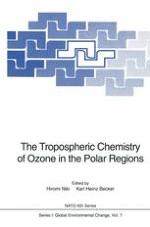1993 | OriginalPaper | Buchkapitel
Halogen and Sulfur Reactions Relevant to Polar Chemistry
verfasst von : P. H. Wine, J. M. Nicovich, R. E. Stickel, Z. Zhao, C. J. Shackelford, K. D. Kreutter, E. P. Daykin, S. Wang
Erschienen in: The Tropospheric Chemistry of Ozone in the Polar Regions
Verlag: Springer Berlin Heidelberg
Enthalten in: Professional Book Archive
Aktivieren Sie unsere intelligente Suche, um passende Fachinhalte oder Patente zu finden.
Wählen Sie Textabschnitte aus um mit Künstlicher Intelligenz passenden Patente zu finden. powered by
Markieren Sie Textabschnitte, um KI-gestützt weitere passende Inhalte zu finden. powered by
It is widely hypothesized that catalytic cycles involving BrOx species play an important role in the episodic destruction of ground-level ozone which is observed in the springtime Arctic boundary layer, although the exact mechanism for production of BrOx radicals remains an open question [Barrie et al., 1988; Bottenheim et al., 1990; Finlayson-Pitts et al., 1990; McConnell et al., 1992]. The critical evidence linking ozone depletion with BrOx chemistry is an observed negative correlation between ozone and filterable bromine [Bottenheim et al., 1990; Kieser et al., 1992]. In a recent field study of springtime Arctic boundary layer chemistry [Kieser et al., 1992], ozone concentrations and ethane concentrations were found to be correlated; this observation suggests that chlorine atoms (which react rapidly with ethane) may also be an important catalyst for ozone destruction under springtime Arctic conditions.
